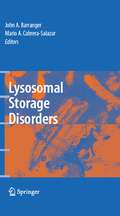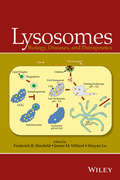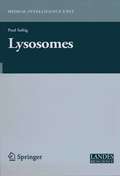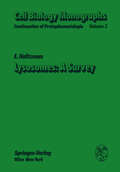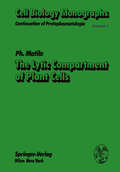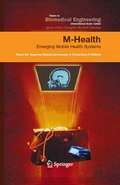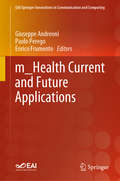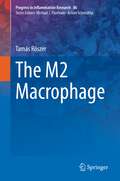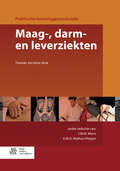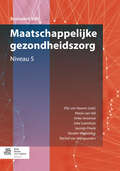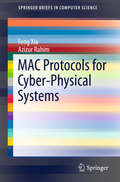- Table View
- List View
Lymphoproliferative Diseases (Immunology and Medicine #15)
by D. B. Jones D. H. WrightRecent developments in the field of cellular pathology and molecular biology have had a major impact on our ability to diagnose lymphoreticular disease and on our understanding of many of the disease processes which contribute to lymphoreticular pathology. Twenty years ago, the immunological analysis of lymphoid proliferations was in its infancy. The techniques available, such as sheep red blood cell rosetting and immune adherence to frozen sections, now appear unbelievably crude when compared with our ability to accurately phenotype lymphocytes in suspension, in frozen section and, more recently, in formalin-fixed, paraffin-embedded tissue biopsies. Four international work shops have also standardized the nomenclature for the wide range of lineage restricted and lineage-related monoclonal antibodies available, and have provided a basis for the sophisticated phenotypic analysis of lymphoid neoplasms in even the smallest routine laboratories. Our concepts relating to the pathogenesis of a number of human lymphomas have also changed substantially, and this has been aided by the development of systems for the classification of human lymphoma which are firmly based in our knowledge of the differentiation and biological behaviour of normal lymphoreticular cells. In this monograph, we present contributions from many authors examining both leukaemia and lymphoma from an immunological perspec tive. It is our hope that some of these contributions will be of practical value in the laboratory investigation and diagnosis of lymphoreticular disease. Other contributions record our conceptual understanding of the histogenesis and pathogenesis of human lymphoma.
Lymphoproliferative Diseases: Proceedings of a symposium presented at the University of Southern California, Department of Pathology and the Kenneth J. Norris Cancer Hospital and Research Institute, Los Angeles, U.S.A., November 16–17, 1984 (Developments in Oncology #31)
by Clive R. Taylor Robert J. Lukes Paul K. PattengaleProceedings of a symposium presented at the University of Southern California, Department of Pathology and the Kenneth J. Norris Cancer Hospital and Research Institute, Los Angeles, U.S.A., November 16-17, 1984
Lymphoreticular Malignancies: Epidemiologic and related aspects
by N.J. ViannaNo disease can exist by itself but rather each must be viewed as the result of some specific interaction between man and his environment. This fact is appreciated even by people in the most primitive of civilisations and prompts them to ask the basic question: 'Why did I develop this disease'? The astute clinician goes beyond establishing a diagnosis and asks similar questions of himself and his patient. Frequently a singular observation resulting from this type of inquiry provides the working hypothesis for the epidemiologist who again asks the same question, not of the individual but of a definable population at risk. As a science, epidemiology is bound to the laws of logic and statistics, but clearly it must go beyond this point. The epidemiologist faced with a statistic ally significant observation must also question" its biologic relevance. He must evaluate the consistency of his findings with the more estab lished features of the disease under study. He must also be sufficiently imaginative to challenge his results with additional studies, different in their methodologic approach; and, of great importance, he must have the courage to be wrong. But epidemiologic studies alone can never determine the specific aetiology of a disease. Other scientific disciplines with their own inherent limitations are also required. Thus, in cancer research, the laboratory investigator frequently employs animal models, but the applicability of results obtained to humans is always subject to question.
Lynch Syndrome: Molecular Mechanism and Current Clinical Practice
by Naohiro TomitaThis book offers a comprehensive review of Lynch Syndrome (LS), addressing both the basic and clinical aspects of this condition. Due to the recent advances in our understanding of the genetic mechanism of LS, and to new screening methods, including universal screening and/or multi-gene panel analysis, the standard treatment strategy for patients and family members of LS have been steadily improving. In this book, experts describe the disease’s manifestations, discuss state-of-the-art diagnosis and management options, and offer a cutting-edge overview of the genetic and epigenetic basis of the syndrome. Providing essential insights into this new phase in the management of LS, this book is a valuable resource not only for colorectal surgeons, but also for general gastrointestinal clinicians, gynecologists, oncologists and all basic researchers with an interest in LS.
Lyophilization of Pharmaceuticals and Biologicals: New Technologies and Approaches (Methods in Pharmacology and Toxicology)
by Kevin R. Ward Paul MatejtschukThis detailed volume brings together leading practitioners in the freeze-drying community to address recent progress, not only in new analytical tools and applications of the data derived in cycle design but also in the manufacturing of lyophilized products in the healthcare sector – whether these be therapeutics, vaccines or diagnostic products - and indeed the equipment to deliver this scale of freeze-drying. Areas of focus include analytical and formulation issues, process monitoring and control, as well as post-lyophilization analysis. Written for the Methods in Pharmacology and Toxicology series, chapters include the type of expert advice that leads to superior results in the lab. Authoritative and practical, Lyophilization of Pharmaceuticals and Biologicals: New Technologies and Approaches serves as an ideal guide for researchers working in or just seeking an update on this rapidly changing field.
Lyophilized Biologics and Vaccines: Modality-Based Approaches
by Dushyant Varshney Manmohan SinghThis book provides a detailed account of the most recent developments, challenges and solutions to seamlessly advance and launch a lyophilized biologics or vaccine product, based on diverse modalities, ranging from antibodies (e.g., monoclonal, fused), complex biologics (e.g., antibody drug conjugate, PEGylated proteins), and vaccines (e.g., recombinant-protein based). The authors adeptly guide the reader through all crucial aspects, from biophysical and chemical stability considerations of proteins, analytical methods, advances in controlled ice nucleation and quality-by-design approaches, alternate drying technology, to latest regulatory, packaging and technology transfer considerations to develop a stable, safe and effective therapeutic protein, vaccine and biotechnology products.Lyophilized Biologics and Vaccines: Modality-Based Approaches is composed of four sections with a total of 17 chapters. It serves as a reference to all critical assessments and steps from early pre-formulation stages to product launch: Provides recent understanding of heterogeneity of protein environment and selection of appropriate buffer for stabilization of lyophilized formulationsDetails the latest developments in instrumental analysis and controlled ice nucleation technology Explains in-depth lyophilized (or dehydrated) formulation strategies considering diverse modalities of biologics and vaccines, including plasmid DNA and lipid-based therapeuticsDetails an exhaustive update on quality-by-design and process analytical technology approaches, illustrated superbly by case studies and FDA perspectiveProvides the latest detailed account of alternate drying technologies including spray drying, bulk freeze-drying and crystallization, supported exceptionally by case studiesProvides a step-by-step guide through critical considerations during process scale-up, technology transfer, packaging and drug delivery device selection, for a successful lyophilization process validation, regulatory submission and product launchChapters are written by one or more world-renowned leading authorities from academia, industry or regulatory agencies, whose expertise cover lyophilization of the diverse modalities of biopharmaceuticals. Their contributions are based on the exhaustive review of literature coupled with excellent hands-on experiences in laboratory or GMP setup, making this an exceptional guide to all stages of lyophilized or dehydrated product development.
Lysosomal Storage Disorders
by John A. Barranger Mario Cabrera-SalazarThe knowledge of lysosomal biology and the consequences of its dysfunction have increased dramatically in the past 60 years. This book describes the nature of the lysosomal dysfunction and diseases as well as potential future treatments and therapies. Disease specific chapters provide thorough reviews of the clinical features of lysosomal storage disorders, their molecular basis and the commercial or experimental therapeutic approaches sought in this area. This is an invaluable resource for researchers in biochemical and molecular genetics, enzyme therapy, and gene transfer.
Lysosomal Storage Disorders: A Practical Guide
by Atul B. Mehta Bryan WinchesterLysosomal Storage Disorders Enables readers to gain both holistic and specific knowledge on the topic of Lysosomal Storage Disorders In the past few decades, we have witnessed a ‘golden age’ of Lysosomal Storage Disorders (LSDs) clinical care, diagnosis, and research and this book is a well-timed review of the rapidly developing subject of LSDs. Contributions from many leading scientists and clinicians in the field provide the reader with a completely comprehensive overview of the subject. Topics covered in the book include: The general aspects of LSDs, with special attention paid to physiology and pathology Clinical and laboratory diagnosis, including newborn screening and the genetics of LSDs Individual LSDs, such as the various sphingolipidoses, mucopolysaccharidoses, glycogen storage disease, glycoproteinoses, galactosialidosis, and neuronal ceroid lipofuscinoses Other disorders of the lysosome, including those involving defects in the lysosomal membrane and in the emerging roles of the lysosome in cellular metabolism The existing and emerging treatments for LSDs Key patient issues such as availability and disease awareness, including in the Third World. For researchers and industry professionals in the field of LSDs, this book serves as a completely comprehensive reference work to understand both theoretical concepts and how they may be used in practical applications. For students of LSDs, it provides a solid base of foundational knowledge and serves as a practical guide.
Lysosomal Storage Disorders: A Practical Guide
by Atul B. Mehta Bryan WinchesterLysosomal Storage Disorders Enables readers to gain both holistic and specific knowledge on the topic of Lysosomal Storage Disorders In the past few decades, we have witnessed a ‘golden age’ of Lysosomal Storage Disorders (LSDs) clinical care, diagnosis, and research and this book is a well-timed review of the rapidly developing subject of LSDs. Contributions from many leading scientists and clinicians in the field provide the reader with a completely comprehensive overview of the subject. Topics covered in the book include: The general aspects of LSDs, with special attention paid to physiology and pathology Clinical and laboratory diagnosis, including newborn screening and the genetics of LSDs Individual LSDs, such as the various sphingolipidoses, mucopolysaccharidoses, glycogen storage disease, glycoproteinoses, galactosialidosis, and neuronal ceroid lipofuscinoses Other disorders of the lysosome, including those involving defects in the lysosomal membrane and in the emerging roles of the lysosome in cellular metabolism The existing and emerging treatments for LSDs Key patient issues such as availability and disease awareness, including in the Third World. For researchers and industry professionals in the field of LSDs, this book serves as a completely comprehensive reference work to understand both theoretical concepts and how they may be used in practical applications. For students of LSDs, it provides a solid base of foundational knowledge and serves as a practical guide.
Lysosomal Storage Disorders: A Practical Guide
by Atul Mehta Bryan WinchesterThe last two decades have seen a huge expansion in research in the area of lysosomal storage disorders, which has substantially extended our understanding of both the scientific and the clinical basis of these diseases. Lysosomal Storage Disorders: A Practical Guide is the fruit of an ambitious project aiming to review both the scientific and the clinical aspects of lysosomal storage disorders, resulting in this accessible volume, which gives an up-to-date overview of the subject. There is substantial scientific interest in these diseases: new advances in small molecule therapy are likely to be useful in the near future, and trials are already underway. Lysosomal storage disorders offer a unique platform for teaching modern clinical science, from basic genetics through to clinical applications. The first part of the book reviews and classifies our current understanding of the physiology and pathophysiology of lysosomal storage disorders. The second part of the book reviews individual diseases, and gives perspectives from patients and experts looking towards future therapeutic directions. Lysosomal Storage Disorders: A Practical Guide is the ideal guide for a wide audience including scientists, clinicians, health care workers and administrators, those working in the pharmaceutical industry, patients and their organisations. Titles of related interest Haematology at a Glance • Mehta • ISBN 9781405179706 Atlas of Endocrine and Metabolic Disease • Pozzilli • ISBN 9780470656273
Lysosomes: Biology, Diseases, and Therapeutics
by Frederick R. Maxfield James Michael Willard Shuyan LuDiscussing recent findings, up-to-date research, and novel strategies, the book integrates perspectives from pharmacology, toxicology, and biochemistry to illustrate the potential of lysosomes in drug discovery and development.• Explores basic principles and properties of lysosomes that allow them to act as regulators of cell metabolism, therapeutic targets, and sites for activation of drug conjugates • Discusses the role of lysosomes in metabolism, drug targeting, apoptosis, cancer, aging, inflammation, autophagy, metabolism, toxicity, and membrane repair• Introduces new pathways in therapeutic development and new mechanisms in drug development
Lysosomes: Biology, Diseases, and Therapeutics
by Frederick Maxfield James Willard Shuyan LuDiscussing recent findings, up-to-date research, and novel strategies, the book integrates perspectives from pharmacology, toxicology, and biochemistry to illustrate the potential of lysosomes in drug discovery and development.• Explores basic principles and properties of lysosomes that allow them to act as regulators of cell metabolism, therapeutic targets, and sites for activation of drug conjugates • Discusses the role of lysosomes in metabolism, drug targeting, apoptosis, cancer, aging, inflammation, autophagy, metabolism, toxicity, and membrane repair• Introduces new pathways in therapeutic development and new mechanisms in drug development
Lysosomes (Medical Intelligence Unit)
by Paul SaftigLysosomes are membrane-surrounded organelles which are present in all animal cells. The importance of this organelle is underlined by an increasing number of human diseases, which are associated with an impaired function of the lysosomal compartment. This book summarizes the current state-of-the art knowledge about this unique organelle. It addresses the biogenesis of this compartment, the transport of lysosomal proteins, the role of the lysosomal membrane in lysosomal stability and transport, the function of lysosomal proteases and hydrolases, lysosomal storage disorders, and new concepts on how to treat these diseases. In addition to these classical topics, new insights into lysosomal functions are covered by chapters dealing with specialized lysosomes involved in bone resorption and plasma membrane repair, the lysosomal transciptome, and proteome and the emerging role of lysosomes in special forms of autophagy. This book will provide readers with a comprehensive overview into how this fascinating organelle works and how research in the field is developing.
Lysosomes: A Survey (Cell Biology Monographs #3)
by E. HoltzmanThis brief monograph is intended chiefly for non-specialists and for others interested in a concise introduction to the field. The literature on lysosomes is growing so rapidly that any effort at exhaustive comprehensiveness would be foredoomed to failure. Fortunately, an extensive series of reviews has been published in the past few years (see especially DINGLE and FELL 1969; DINGLE 1972, 1973 a; HERS and VAN HoOF 1973) and the "history" of the organelles is brief enough that major contributors to all stages of that history are still available to provide first-hand discussions (e. g. , DE DUVE and WATTIAUX 1966; DE DUVE 1969; NOVIKOFF 1971, 1973; see also VAN FURTH for work on phago cytes and DE REUCK and CAMERON 1963 for useful reviews of early work). New York, N. Y. , September 1975 E. HOLTZMAN Contents I. General Considerations and Background 1. 1. Perspectives 1 1. 2. Definitions . 2 1. 2. 1. General Functional Categories 2 1. 2. 2. Outline of Lysosome Functioning in Phagocytes 3 1. 2. 3. Additional Terms: Heterophagy and Autophagy 4 1. 3. Characterization of Lysosomes . . . . . . . . . . 4 1. 3. 1. Basic Biochemical Characteristics of Lysosomes 5 1. 3. 1. 1. Key Features of Lysosomes 8 1. 3. 1. 2. The Lysosomal Enzymes . 8 1. 3. 1. 3. Digestion in Lysosomes 11 1. 3. 104. Lysosomal "Permeability" 13 1. 3. 2. Some Cytochemical and Morphological Characteristics 15 1. 3. 2. 1. Cytochemical Methods . . . . . . . . . . 16 1. 3. 2. 2. Cytochemical Studies of Exogenous Tracers .
The Lytic Compartment of Plant Cells (Cell Biology Monographs #1)
by P. MatileAlmost twenty years ago DE DuvE discovered the existence in rat liver cells of a novel class of subcellular structures which he termed lysosomes. As the lysosomes are the seat of various hydrolytic enzymes this discovery greatly stimulated the interest in cellular digestive processes. It is now recognized that compartmentation of hydrolases is an outstanding example of the dependence of metabolic functions on cell structure. The important role of lytic processes in plant metabolism made it interesting to correlate the facts on the various phenomena and present them from the point of view of cellular compartmentation. It is not intended to survey in extenso the litera ture on the various aspects of localization and function of hydrolases in plant cells as this would be an impossible task. The aim of this monograph is to emphasize the significance of hydrolase compartmentation rather than to strive for complete coverage of work on hydrolases in which other viewpoints have been considered. I thank Miss SONIA TURLER for her great help with the manuscript. I also wish to acknowledge the assistance given by Dr. ELSA HAUSERMANN, Mrs. DORLI FURRER, and Mrs. SILVIA STUNZI. Moreover, I am indebted to my collaborators and particularly to my colleague Dr. A. WIEMKEN for frequent and stimulating discussions on the subject. Zurich (Switzerland), February 1975 PH. MATILE Contents Abbreviations . XIII Introduction: Lysis and the Lytic Compartment. 1 1. Hydrolases and their Localization . . . . . 3 1. 1. Classification and Properties of Hydrolases 3 1. 1. 1. Peptidases . . . . . . . . .
M-Health: Emerging Mobile Health Systems (Topics in Biomedical Engineering. International Book Series)
by Robert Istepanian Swamy Laxminarayan Constantinos S. PattichisM-health can be defined as the ‘emerging mobile communications and network technologies for healthcare systems.' This book paves the path toward understanding the future of m-health technologies and services and also introducing the impact of mobility on existing e-health and commercial telemedical systems. M-Health: Emerging Mobile Health Systems presents a new and forward-looking source of information that explores the present and future trends in the applications of current and emerging wireless communication and network technologies for different healthcare scenaria. It also provides a discovery path on the synergies between the 2.5G and 3G systems and other relevant computing and information technologies and how they prescribe the way for the next generation of m-health services. The book contains 47 chapters, arranged in five thematic sections: Introduction to Mobile M-health Systems, Smart Mobile Applications for Health Professionals, Signal, Image, and Video Compression for M-health Applications, Emergency Health Care Systems and Services, Echography Systems and Services, and Remote and Home Monitoring. This book is intended for all those working in the field of information technologies in biomedicine, as well as for people working in future applications of wireless communications and wireless telemedical systems. It provides different levels of material to researchers, computing engineers, and medical practitioners interested in emerging e-health systems. This book will be a useful reference for all the readers in this important and growing field of research, and will contribute to the roadmap of future m-health systems and improve the development of effective healthcare delivery systems.
m_Health Current and Future Applications (EAI/Springer Innovations in Communication and Computing)
by Giuseppe Andreoni Paolo Perego Enrico FrumentoThis book describes current trends in m_Health technology, systems, and applications. The book proposes a multifaceted view on m-Health opportunities and requirements starting from four aspects: patient, technology, design and innovation. The analysis is completed by a market segmentation overview and by the most recent research experiences to offer a complete benchmark and vision of m_Health for today and tomorrow. The contributions are based on the outcomes of initiatives on the future of healthcare, funded by the EU in the frame of FP7 and Horizon 2020 and their deployment into real clinical practice. Throughout the book, clinicians, technicians, researchers, and end-users debate their experience, needs, risks, opportunities, and available solutions in this fast moving field.
The M2 Macrophage (Progress in Inflammation Research #86)
by Tamás RöszerMacrophages are core components of the innate immune system. Once activated, they may have either pro- or anti-inflammatory effects that include pathogen killing, safe disposal of apoptotic cells or tissue renewal. The activation state of macrophages is conceptualized by the so-called M1/M2 model of polarization. M2 macrophages are not simply antagonists of M1 macrophages; rather, they represent a network of tissue resident macrophages with roles in tissue development and organ homeostasis. M2 macrophages govern functions at the interfaces of immunity, tissue development and turnover, metabolism, and endocrine signaling. Dysfunction in M2 macrophages can ruin the healthy interplay between the immune system and metabolic processes, and lead to diseases such as insulin resistance, metabolic syndrome, and type 1 and 2 diabetes mellitus. Furthermore, M2 macrophages are essential for healthy tissue development and immunological self-tolerance. Worryingly, these functions of M2 macrophages can also be disrupted, resulting in tumor growth and autoimmunity. This book comprehensively discusses the biology of M2 macrophages, summarizes the current state of knowledge, and highlights key questions that remain unanswered.
Ma, I've Got Meself Locked Up in the Mad House
by Martha LongMartha is now in her thirties. Her daughter has left home and she is lonely and vulnerable. The hard knocks have taken their toll on her health, and as she looks into the years still lying ahead of her, she shakes her head, feeling she hasn't the heart or the strength to go on.As she teeters on the brink of a nervous breakdown, a phone call summons ghosts from the past. She discovers that one of the family is dead and the others need her help. Martha returns and when she comes face to face with the evil, psychotic Jackser, she can no longer suppress the nightmares of her childhood.A suicide attempt sees her admitted to the 'mad house', where a hunger strike takes her even nearer to death. But finally she sees a chink of light at the end of the tunnel. Could love in an unexpected form pull her back from the brink?
Ma Vie en Noir: Fifty Years with Melatonin and the Stone of Madness (Springer Biographies)
by Daniel Pedro CardinaliI wrote this book urged by the overwhelming desire that arises towards the end of life to recapitulate the past. My goal was to summarize my experience of practicing science at the end of the 20th and early 21st centuries in Argentina, a country located far away from the world’s leading scientific centers. In the book, I summarize the intricacies of the pineal gland (“the stone of madness”) as historical, mystical and medical entity and its entry in contemporary medicine with the description of melatonin. I also reflect on how being associated with an unexplored subject at the beginning of his scientific career impacts the life of a scientist throughout their entire life. Today we know that in humans pineal melatonin is released every day late in the evening, and there is evidence that it is the trigger for the sleep process. But the most exciting aspect of melatonin is that it is a substance that is present in all living creatures, from unicellular organisms to plants and higher mammals, a fact that evinces its importance for life. Further, the neuroprotective action of melatonin promises to be crucial for the control of neurodegenerative diseases we face as a pandemic in this century. The discoverer of melatonin, Aaron Lerner, based its name on melano, the Greek word for black, because of its effect on the pigment cells of the skin. As in "La vie en rose", the immortal Edith Piaf song written in 1946, my lifelong work with melatonin could well be called "Ma vie en noir".
Maag-, darm- en leverziekten (Praktische huisartsgeneeskunde)
by J.W.M. Muris E.M.H. Mathus-VliegenAls zelfstandige discipline is het specialisme Maag-, Darm- en Leverziekten een betrekkelijk jong vak. In korte tijd is veel kennis over de (patho)fysiologie, de diagnostiek en therapie verworven. Vertaling hiervan naar de huisartsenpraktijk is een grote wens. Het boek Maag-, darm- en leverziekten binnen de serie Praktische huisartsgeneeskunde voldoet hieraan. Het boek biedt een compleet en actueel overzicht van de huidige inzichten en is natuurlijk, zoals alle delen in de reeks Praktische huisartsgeneeskunde, praktijkgericht.Maag-, darm- en leverziekten behandelt niet alleen de fysiologie en de pathologie van het maagdarmkanaal in engere zin. Het vakgebied is breder gedefinieerd: u krijgt een volledig overzicht van het spijsverteringskanaal inclusief de lever en de pancreas, de pathologie ervan en alle relevante ziekten die kunnen voorkomen. De klachtgerichte opzet maakt de informatie praktisch toepasbaar. Dit wordt nog versterkt door de casuïstiek die de behandelde stof inzichtelijker maakt. Ook bevat het boek specifieke hoofdstukken over de endoscopie, de indicatie en toepassing van voedingssondes en de problematiek rondom stoma's en een overzicht van de vele patiëntenorganisaties. Deze uitgave is vernieuwd ten opzichte van de vorige druk die Gastro-enterologie heette en bovendien zijn er enkele nieuwe hoofdstukken aan toegevoegd.Maag-, darm- en leverziekten verschijnt in de reeks Praktische huisartsgeneeskunde. In deze reeks verschijnen uitgaven met praktische en klachtgerichte informatie over de verschillende deelgebieden in de huisartsgeneeskunde. Maag-, darm- en leverziekten is op de eerste plaats bestemd voor huisartsen, al dan niet in opleiding. Daarnaast voor gespecialiseerde verpleegkundigen, nurse practitioners, physician assistants, basisartsen, praktijkondersteuners en medische studenten.
Maatschappelijke gezondheidszorg: Niveau 5 (Basiswerken Verpleging en Verzorging)
by Marjo van Hal Anke Jeroense Joke Leemhuis Jasmijn Pronk Marijke Wigboldus Rachel van WijngaardenDe maatschappelijke gezondheidszorg (MGZ) is een belangrijk en veelomvattend deel van onze gezondheidszorg. De overheid wil de kosten voor de zorg in de hand houden en doet daarom een toenemend beroep op alle burgers. We moeten zo gezond mogelijk leven, zo lang mogelijk thuis blijven wonen en voor onszelf én elkaar zorgen. Professionele zorg wordt pas ingeschakeld als het netwerk niet zelf in hulp kan voorzien. De overheid wil dat de zorg waar mogelijk in de thuissituatie plaatsvindt en zo laag mogelijk in de keten wordt verleend. De MGZ is daarvoor bij uitstek geschikt. Verpleegkundigen in de MGZ moeten mee in deze ontwikkeling en de juiste vaardigheden hebben. Dat vraagt om kritische verpleegkundigen met uiteenlopende competenties, hart voor de vele doelgroepen en bereidheid om met andere disciplines samen te werken. Maatschappelijke gezondheidszorg biedt verpleegkundigen in de MGZ veel relevante informatie en maakt hen wegwijs in de thuiszorg, eerstelijnszorg, transmurale zorg, arbozorg en publieke gezondheidszorg. Het boek schetst de organisatie van de verschillende zorgsectoren, de mensen die er werken, de doelgroepen, de stand van zaken op het gebied van ziekte en gezondheid, recente ontwikkelingen en de wetgeving die voor de MGZ van belang is. Een belangrijk onderdeel van de MGZ is preventie, naast lichamelijke zorgverlening en psychosociale begeleiding. Daarom worden vormen van preventie en preventiemodellen beschreven. De MGZ is voortdurend bezig de kwaliteit van de zorg te verhogen. Zorgorganisaties en zorgverleners gebruiken kwaliteitssystemen, baseren hun werk op landelijke richtlijnen en werken zoveel mogelijk evidence-based. Zorgconcepten als disease management en zelfmanagement stimuleren patiënten om de regie in eigen hand te nemen. Zorgpaden en ketenzorg zijn manieren om de zorg van al die zorgverleners op elkaar te laten aansluiten. Wat dat allemaal inhoudt, komt in dit boek uitgebreid aan bod. Maatschappelijke gezondheidszorg helpt verpleegkundigen hun weg in de MGZ te vinden.
MAC Protocols for Cyber-Physical Systems (SpringerBriefs in Computer Science)
by Feng Xia Azizur RahimThis book provides a literature review of various wireless MAC protocols and techniques for achieving real-time and reliable communications in the context of cyber-physical systems (CPS). The evaluation analysis of IEEE 802.15.4 for CPS therein will give insights into configuration and optimization of critical design parameters of MAC protocols. In addition, this book also presents the design and evaluation of an adaptive MAC protocol for medical CPS, which exemplifies how to facilitate real-time and reliable communications in CPS by exploiting IEEE 802.15.4 based MAC protocols. This book will be of interest to researchers, practitioners, and students to better understand the QoS requirements of CPS, especially for healthcare applications.








